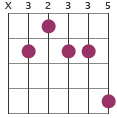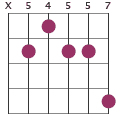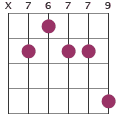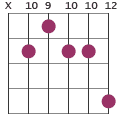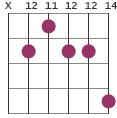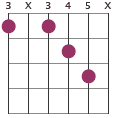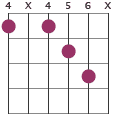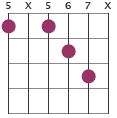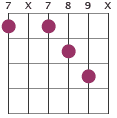13th chords
The 13th chord expands the 11th chord with another tone, hence the name, this tone is 13 steps from the root. A pianist could play this chord with seven tones, but the guitar is limited to six tones, and therefore, at least one tone is always excluded. The omitted tone, or the omitted tones, can vary depending on the chord shape.
13
C13
D13
E13
F13
G13
A13
B13
Comments
The shape presented is similar to the movable 9th chord. If you don't feel comfortable with the stretch, more shapes follow below.
13th chords with flats and sharps
Additional chords in this category:
C sharp / D flat 13th: X45446
D sharp / E flat 13th: X67668
F sharp / G flat 13th: 242342
G sharp / A flat 13th: 464564
A sharp / B flat 13th: 686786
Chord progressions
Progressions including this chord type:
E9 - E13 - E9 - E13 - E9 (see tab)
Chord structure
The 13th chord is built with the formula 1-3-5-b7-9-11-13 (root, major 3rd, perfect 5th, minor 7th, major 9th, perfect 11th and major 13th). A tip for memorizing all the chord notes, note that C13 can be built from a C7 and a D minor, D13 can be built by a D7 and an E minor, and so on.
Chord construction
C13 x - C - E - Bb - D - AD13 x - D - F# - C - E - B
E13 x - E - G# - D - F# - C#
F13 x - F - A - Eb - G - D
G13 x - G - B - F - A - E
A13 x - A - C# - G - B - F#
B13 x - B - D# - A - C# - G#
Guitar versions of the chord
Notes in chord
C13 C - E - G - Bb - D - F - AD13 D - F# - A - C - E - G - B
E13 E - G# - B - D - F# - A - C#
F13 F - A - C - Eb - G - Bb - D
G13 G - B - D - F - A - C - E
A13 A - C# - E - G - B - D - F#
B13 B - D# - F# - A - C# - E - G#
The intervals are 1 - 3 - 5 - b7 - 9 - 11 - 13
Alternative chord shapes
G13
G#13 / Ab13
A13
B13
Besides the chord pictures above, there are more ways to play the 13th chord. In the diagrams above you can see alternatives.
This shape is movable with the root on the 6th string and muted 5th string:
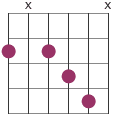
For example, G13, would be played as 3X345X with the shape above. The fifth is omitted in this fingering. You can also include the high e-string as 3X3457, with the thumb taking care of the 6th string. A third, and not very convenient alternative, is to use the shape 32345X by once again involving the thumb.
Progressions including this chord type:
Dmaj7 - Dm7 - G13 - Cmaj7 - F9 - Bbmaj7 (see tab)
Bass note left out for a funkier sound:
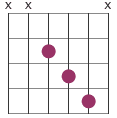
In this chord shape, you will mute the second string with an adjacent finger.
This chord can sound great with a single stroke as an outro, for example in a 12-bar blues (as a last stroke, in the last bar). (The similar shape 3X3455 is sometimes also referred to as G13, but is more correctly referred to as G13 6/9.)
These are two common voicings:
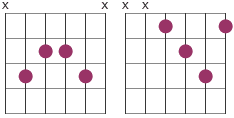
On the diagram to the left, the root is on the 2nd string and on the diagram to the right, the root is on the 1st string. Two examples written in short notations are E13: X5665X and F13: XX1231.
13th chord in open position
The 13th chords are most often played in closed positions as shown in diagrams above, but here are some suggestions for open 13th chords:
C13/Bb: X1221X
D13: X54500
E13: 020120
F13: 100011
G13: 3X3200
A13: X02022
A#13 / Bb13: X10113
B13: X0110X
Dominant 13th chord inversions
A 13th chord can be played in numerous configurations including six inversions (it's also common to combine inversions with omitting notes for this chord type).
C13 can be used as an example:
- C - E - G - Bb - D - F - A (root position)
- E - C - G - Bb - D - F - A (1st inversion)
- G - C - E - Bb - D - F - A (2nd inversion)
- Bb - C - E - G - D - F - A (3rd inversion)
- D - C - E - G - Bb - F - A (4th inversion)
- F - C - E - G - Bb - D - A (5th inversion)
- A - C - E - G - Bb - D - F (6th inversion)
To indicate that a chord is played inverted it is written with a slash before the bass note. For example, the first inversion of the C13 chord is written C13/E. Some examples follow below in short notation:
C13/E: 032335
C13/Bb: X10210
C13/F: 110210
D13/F#: 220210
D13/C: X30202
E13/F#: 220120
E13/B: X20120
F13/A: X01031
F13/C: X33233
G13/B: X22031
G13/E: 002001
G13/F: 100000
A13/E: 004020
A13/G: 304420
B13/E: 021224
B13/F#: 201102
One of the movable shapes that can be used for the fourth inversion is with the root on the second string:
C13/Bb: X1221X
D13/C: X3443X
F13/Eb: X6776X
G13/F: X8998X
For more chord diagrams, see The Chord Reference ebook.
13th chord alterations
Alterations mean that a note in the chord is altered, for example, a flattened fifth. Here is an example using C as root tone (the shape is movable).
C13b9: X32325
In C13b9 the ninth is flattened.
